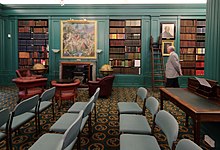Edward Halliday
Edward Irvine Halliday (1902–1994) was a British painter, known for his portraits and his murals in the 1920s.[1] He also worked in television and radio as a host.
Edward Halliday | |
|---|---|
| Born | 7 October 1902 Garston, Liverpool |
| Died | 2 February 1984 London, England |
| Education | Liverpool College of Art, Académie Colarossi, Royal College of Art, British School at Rome |
| Known for | painting, portraiture, radio/television host |

About
Edward Irvine Halliday was born on 7 October 1902 at Garston, Liverpool to parents James Halliday and Violet Irvine.[2] He first attended Liverpool College of Art.[3] Halliday continued his studies and attended life drawing classes at Académie Colarossi (1922–1923), the Royal College of Art (1923–1925), and the British School at Rome (1925–1928).[4][5] He was awarded the Prix de Rome for Decorative Painting in 1925.[3][6]
He established himself as a portrait artist with his work, Lord Darling (1928).[7]
During World War II, Halliday served in the Royal Air Force in Bomber Command.[7] After the war in 1948, he received a painting commission for a portrait of Princess Elizabeth from the Drapers' Company of London.[7] This was the start of many more royal portrait commissions. Other sitters for Halliday's portraits included Winston Churchill, Edmund Hillary, Lord Denning, Lord Widgery, Louis Gluckstein, Robert Stopford, Lord Hunt, Frank Whittle, Malcolm Sargent, Leon Goossens, Beryl Grey, Gladys Cooper, Wally Hammond, Brian Johnston, and Ben Travers.[7]
Halliday had two arts series radio programs, Artists at Work (1932) and Design in Modern Life (1934).[7] After the success of these radio programs, it led to further radio and television work.[7] In the 1950s, Halliday was the voice behind the BBC Television Newsreel.[7]
Death and legacy
He died at his London home in St John's Wood, on 2 February 1984.[7] His daughter Charlotte Halliday is a painter.[8]
Halliday's work is in many public museum collections including National Portrait Gallery, London, National Maritime Museum, Bank of England Museum, Parliamentary Art Collection, among others.[9]
References
- "Edward Irvine Halliday". Artnet.com. Retrieved 2020-06-17.
- Matthew, H. C. G.; Harrison, B., eds. (2004-09-23), "The Oxford Dictionary of National Biography", The Oxford Dictionary of National Biography, Oxford: Oxford University Press, pp. ref:odnb/31191, doi:10.1093/ref:odnb/31191, retrieved 2020-06-17
- Dobson, Frank; Rushbury, Henry; Rutherston, Albert Daniel; Halliday, Edward (1933). Artists at work: based on a series of broadcast dialogues between the editor and Frank Dobson, Henry Rushbury, Albert Rutherston and Edward Halliday. G.G. Harrap & co., ltd. p. 104.
- "Edward Irvine Halliday". National Portrait Gallery, UK. Retrieved 2020-06-17.
- Compton, Ann (1997). Edward Halliday: Art for Life, 1925-1939. Liverpool Science Fiction Texts and Studies. Liverpool, UK: Liverpool University Press. pp. 10–11, 18, 44. ISBN 9780853239727.
- "National Programme Daventry 20.20: 'ARTISTS AT WORK'— V". BBC Genome. The Radio Times, Issue 449. 10 May 1932. pp. 29–30. Retrieved 2020-06-17.
Mr. Halliday, who studied art at Liverpool, Paris, and the Royal College of Art, was the winner of the coveted Prix de Rome for Decorative Painting in 1925.
- Butler, George; Compton, Ann. "Portrait of Sir Isaac Hayward, 1884–1976, trade unionist and local politician". Artware Fine Art. Retrieved 2020-06-17.
- Brodie, Louise (2012-04-15). "Charlotte Halliday". St John's Wood Memories. Retrieved 2020-06-17.
- "Edward Irvine Halliday, 1902–1984, British". Art UK. Retrieved 2020-06-17.